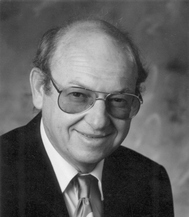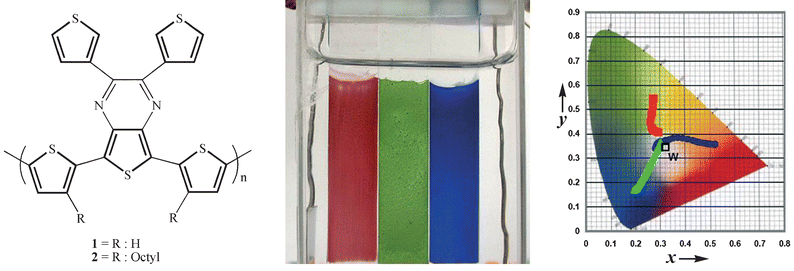Completion of the three primary colours: the final step toward plastic displays
Gürsel
Sonmez
* and
Fred
Wudl
*
Department of Chemistry and Biochemistry and Exotic Materials Institute, University of California, Los Angeles, CA 90095-1569, USA. E-mail: sonmez@sabanciuniv.edu; wudl@chem.ucla.edu
First published on 1st December 2004
Abstract
A completion of the three primary colours (red, green and blue (RGB)) in conjugated polymeric electrochromics is enough to produce any shade of desired colour for plastic displays. Until our first report about a green-coloured neutral conjugated polymer (CP) [G. Sonmez, C. K. F. Shen, Y. Rubin and F. Wudl, Angew. Chem., Int. Ed. Engl., 2004, 43, 1498; G. Sonmez, H. B. Sonmez, C. K. F. Shen, R. W. Jost, Y. Rubin and F. Wudl, Macromolecules, 2005, in press; G. Sonmez, H. B. Sonmez, C. K. F. Shen and F. Wudl, Adv. Mater., 2004, 16, 1905; refs. 1–3], researches on CPs as electrochromics have mainly focused on red and blue colours. In this article we describe the advantages of CPs as electrochromics and the importance of having RGB colours in polymeric electrochromic devices.
 Gürsel Sonmez | Gürsel Sönmez obtained his PhD (2002) in chemistry from Istanbul Technical University working with Prof. A. Sezai Sarac. As a part of his PhD studies, he worked on electrochromic polymers in Prof. John R. Reynolds' group at the University of Florida as a research associate. After completing his PhD, he moved to the University of California, Los Angeles as a postdoctoral fellow working with Prof. Fred Wudl on new polymeric electrochromics, low band gap polymers and novel conjugated molecules. He has been awarded the California Nano-Systems Institute (CNSI) Postdoctoral Award and Postdoctoral Research Excellence Award at UCLA in 2004. He has recently moved to the Sabanci University in Turkey as a faculty member at Faculty of Engineering and Natural Sciences. |
 Fred Wudl | Fred Wudl is the Dean M. Willard Professor of Chemistry and Materials and Director of the Exotic Materials Institute at the University of California, Los Angeles. He received his B.S. (1964) and PhD (1967) degrees in chemistry from UCLA where his dissertation work was done with Prof. Donald J. Cram. After postdoctoral research with R. B. Woodward at Harvard, he joined the faculty of the State University of New York at Buffalo. He then moved, first in 1972 to AT&T Bell Laboratories, and subsequently to the University of California, Santa Barbara in 1982, then onto UCLA in 1997. He is most widely known for his work on organic conductors and superconductors. He discovered the electronic conductivity of the precursor to the first organic metal and superconductor. In the recent past he has been interested in electronically conducting polymers, where he discovered the first transparent organic conductor and the first self-doped polymers. Currently he is interested in the optical and electrooptical properties of processable conjugated polymers as well as in the organic chemistry of fullerenes and the design and synthesis of self-mending polymers. |
Electrochromism can be defined as the reversible change in optical properties of a material resulting from electrochemically induced redox states. First studies and commercial interests in electrochromic materials started with inorganic compounds such as tungsten trioxide (WO3) and iridium dioxide (IrO2).4 Later, organic materials [i.e., viologens, metallophtalocyanines and CPs] have received more attention than inorganics for electrochromic applications because of the different colours observed with these compounds while switching among their redox states.5–7 Although CPs in particular have several advantages over inorganic compounds; i.e., outstanding coloration efficiency, fast switching ability,8 multiple colours with the same material,9 fine-tuning of the band gap (and the colour) through chemical structure modification,10 high stability,11 thin film flexibility and cost effectiveness, they have not received enough attention in terms of applications. One of the main reasons for this was the deficient third leg (green) of colour space in CPs.
As explained here and elsewhere by modifying the conjugated backbone, many differently coloured polymers can be synthesized.12,13 But, on the other hand and according to colour mixing theory,14 it would also be possible to obtain all colours necessary for commercial electrochromic applications of CPs once green is available. Theoretically,13 if two colour stimuli are mixed, the resulting colour stimulus will lie somewhere along the straight line connecting the two points on the chromaticity diagram. The position of the point depends on the ratio of the amounts of the two mixed colours. A “fine-tuning” of colour is possible by adjusting film thickness, because the latter has a large influence on the colour due to its effect on the brightness of the transmitted light. As an example, on a television screen or computer monitor, colour pictures are produced by tiny points (pixels) consisting of three individual areas that can be controlled individually and are equipped with colour filters. In modern flat-panel displays, this control is achieved by applying a voltage to a cell filled with liquid crystals. The cell thus acts as a kind of switchable light “valve” that can either be transparent or opaque. These expensive cells of liquid crystals could be left out if it were only possible to directly switch the light filters themselves off and on. In principle, such a solution is feasible with the use of coloured, electrically conducting plastics that are also electrochromic. For use in displays, the polymers should switch between one of the three primary colours and a transparent state. Unfortunately, as it was stated in our previous study,1 most of the polymers studied so far mainly absorb/reflect blue and red colours in their neutral states. Since absorption at only one dominant wavelength is required to get blue or red colours, it is relatively easy to get these colours by tuning the band gap of a conducting polymer. For green colour, at least two chromophores are required that absorb at two different wavelengths, where blue and red colours absorb. While these chromophores absorb red and blue colours in the neutral form of the polymer, they should also deplete together when the polymer is oxidized. Unfortunately generation of both chromophores at the same time with the same applied potential is very difficult. This difficulty to control two absorption bands in the visible from the same polymer delayed the realization of the first green neutral polymer.1
The conjugated polymer, poly[2,3-di(thien-3-yl)-5,7-di(thien-2-yl)thieno[3,4-b]pyrazine] (DDTP) (1) reflects green light in the neutral state and is transmissive in the oxidized state.1 Dioctyl substitution of DDTP produced a more soluble material, poly[5,7-bis-(3-octyl-thiophen-2-yl)-2,3-dithiophen-3-ylthieno[3,4-b]pyrazine] (2), the first soluble green electrochromic conjugated polymer in its neutral form.2 A combination of green (1 and 2) with other red [i.e., poly(3-alkylthiophene), poly(3,4-ethylenedioxypyrrole), poly(2-methoxy-5-(2′-ethyl-hexyloxy) paraphenylene vinylene),…] and blue [i.e., poly(3,4-ethylenedioxythiophene), poly(isothianaphthene), poly(3,3-dimethyl-3,4-dihydro-2H-thieno[3,4-b]dioxepine),…] completes the RGB additive colour-space as shown in Fig. 1 using 1, poly(3-methylthiophene) and poly(3,4-ethylenedioxythiophene) as green, red and blue, respectively.
 | ||
Fig. 1 (Left) Structure of the polymers which reflect green colour; (middle) red, green and blue colours obtained from poly(3-methylthiophene), 1 and poly(3,4-ethylenedioxythiophene), respectively (0.1 M tetrabutylammonium hexafluorophosphate in dichloromethane was used as electrolyte solution); (right) representation of hue and saturation x
−
y track for poly(3-methylthiophene)
( ), 1
( ), 1
( ) and poly(3,4-ethylenedioxythiophene)
( ) and poly(3,4-ethylenedioxythiophene)
( ) film as the applied potential changes from −0.8 V to +0.8 V vs. Ag/Ag+. ) film as the applied potential changes from −0.8 V to +0.8 V vs. Ag/Ag+. | ||
In conclusion, we believe that with the completion of additive primary colour-space through the discovery of the first green polymeric electrochromic, the PECD era is now open. Taking advantage of diverse properties of conducting polymers in combination with recent developments in inkjet printing technologies will make it possible to print them with precise resolution on flexible substrates.15
Acknowledgements
Permanent address for Gursel Sonmez: Sabanci University, Faculty of Engineering and Natural Sciences, Orhanli, Tuzla 34956, Istanbul, Turkey. We gratefully acknowledge financial support from the Air Force Office of Scientific Research through F49620-00-1-0103 and the Army Research Office through MURI DAAD19-99-1-0316.References
- G. Sonmez, C. K. F. Shen, Y. Rubin and F. Wudl, Angew. Chem,. Int. Ed. Engl., 2004, 43, 1498 CrossRef CAS.
- G. Sonmez, H. B. Sonmez, C. K. F. Shen, R. W. Jost, Y. Rubin and F. Wudl, Macromolecules, 2005, in press Search PubMed.
- G. Sonmez, H. B. Sonmez, C. K. F. Shen and F. Wudl, Adv. Mater, 2004, 16, 1905 CrossRef.
- W. C. Dautremont-Smith, Displays, 1982, 3, 3 CrossRef CAS.
- P. M. S. Monk, R. J. Mortimer and D. R. Rosseinsky, Electrochromism: Fundamentals and Applications, VCHWeinheim, Germany, 1995 Search PubMed.
- K. Bange and T. Gambke, Adv. Mater., 1990, 2, 10 CAS.
- R. J. Mortimer, Electrochim. Acta, 1999, 44, 2971 CrossRef CAS.
- A. Kumar, D. M. Welsh, M. C. Morvant, F. Piroux, K. A. Abboud and J. R. Reynolds, Chem. Mater., 1998, 10, 896 CrossRef CAS.
- G. Sonmez, H. Meng and F. Wudl, Chem. Mater., 2004, 16, 574 CrossRef CAS.
- G. Sonmez, I. Schwandemann, P. Schottland, K. Zong and J. R. Reynolds, Macromolecules, 2003, 36, 639 CrossRef.
- G. Sonmez, H. Meng, Q. Zhang and F. Wudl, Adv. Funct. Mater., 2003, 13, 726 CrossRef CAS.
- S. A. Sapp, G. A. Sotzing and J. R. Reynolds, Chem. Mater., 1998, 10, 2101 CrossRef CAS.
- B. C. Thompson, P. Schottland, K. Zong and J. R. Reynolds, Chem. Mater., 2000, 12, 1563 CrossRef CAS.
- R. D. Overheim, D. L. Wagner, Light and Color, Wiley, New York, 1982 Search PubMed.
- MRS Bull., 2003, 28 Search PubMed.
| This journal is © The Royal Society of Chemistry 2005 |
